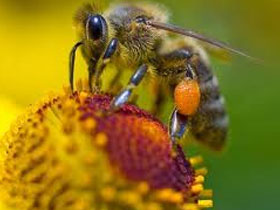.jpg) There is an astonishing order in every stage of the social life of bees, with their many miraculous characteristics. The rules in the bee hives and bees’ scrupulous implementation of these rules is just one of these miraculous features. In addition to the rules in the hive, there is another important factor that regulates and supervises the order in their social life: the bees’ leader, in other words the queen.
There is an astonishing order in every stage of the social life of bees, with their many miraculous characteristics. The rules in the bee hives and bees’ scrupulous implementation of these rules is just one of these miraculous features. In addition to the rules in the hive, there is another important factor that regulates and supervises the order in their social life: the bees’ leader, in other words the queen.
It can be seen from a short examination of the bee hive that the worker bees devote very special attention to one bee much larger than themselves. This bee, the feeding, cleaning, and protection of which, as well as all its other needs, are taken care of by other bees, is the queen, who ensures the continuity of the colony.
The Queen: A Very Different Bee
The number of worker bees in a hive may be in the tens of thousands, though there is only one queen. The presence of the queen is of vital importance for the bees, because it is she who lays the eggs that ensure the survival of the colony. The privileged status of the queen begins right from the larva stage. Queens are raised in places with different features to those of other cells. This place where the queen is reared consists of specially prepared cells that hang down from the comb. Since the queen is larger in size than the other bees, it is natural that these cells should be built to be larger than other cells. (1)
The miraculous point here is that the egg that produces the queen is no different to those that produce worker bees.
Due to feeding differences, during the six-day larva stage, a queen bee with a very different appearance and functions to those of a normal female bee emerges. Worker bees are only given royal jelly for three days, whereas the queen is fed with this very valuable substance throughout the entire larval period (six days). (2) The content and amount of the royal jelly fed to the queen are carefully regulated. Research has shown that while the queen is given 10 mg of royal jelly throughout the larval stage, worker bees are only given 3 mg. Two living things, the queen bee and the worker bee, with various morphological (structural) differences between them emerge as a result of this feeding difference alone. (3)
Differences between the Queen and Other Bees
The queen differs from other bees in general structure and external appearance. For example, although the worker bees are female, so is the queen. Their ovaries do not develop; in other words, they are sterile. A queen’s head and thorax (body section) are not much larger than those of worker bees. In total contrast to worker bees, the queen’s jaw lacks the appropriate structure for building wax cells. The queen also lacks the tough hairs that constitute the workers’ pollen sacs. One of the important differences is that, although the queen emerges from an identical egg, she has a life span of four to five years rather than the five to six weeks, (a few months in those around in the winter), of worker bees. This is again solely due to feeding differences.
These are just a few examples of the general differences between the queen and other bees. One point worthy of note here is that female bees emerge as queens or workers solely on the basis of nutritional differences.
How Does the Queen Regulate the Gender of Other Bees?
One of the most extraordinary attributes of the queen bee is her ability to regulate the genders of the bees in the hive. The queen regulates gender by opening and closing the mouth of the sac in which sperm are preserved. This sac is connected to the egg laying tube by a thin channel. When the queen wishes to lay a female egg she contracts her muscles, drawing a few sperm from the small sac connected to the egg passage channel, and these fertilise the egg there. As a result of this function given to the queen, female bees hatch from fertilized eggs and males from non-fertilised ones. (4) Despite the queen bee’s regulation of the eggs, it is actually the workers who determine the egg’s gender. Because the egg-laying performed by the queen is carried out in accordance with the cell type prepared by the workers. If the cell the queen approaches is a 5.2 mm standard cell, she will lay a female egg, whereas if it is 1 mm larger, she will lay a male egg in it. (5)
 Queen Bees Behave under Allah’s Inspiration
Queen Bees Behave under Allah’s Inspiration
All of the details in the lives of queen bees we have examined so far reveal the existence of exceedingly conscious behaviour, a perfect social order, and of designs appropriate to that order. The organism referred to as the queen bee is actually an entity just a few centimetres in length with a brain consisting of very simple synapses. How is it possible for this animal to comprehend why the cells will be constructed and to lay the appropriate egg without confusing them, through its own will and intelligence?
From the moment she hatches to the moment she leaves the hive, the queen bee knows exactly what she has to do. In the verse, “Your Lord revealed to the bees…” (Surat An-Nahl, 68), Allah reveals that all the animal’s actions and the conscious behaviour it displays take place under His inspiration. As with all other living things, Almighty Allah has created queen bees with bodily systems that are completely appropriate to the lives they lead. He is the Creator of all. In one verse from the Qur’an, our Lord reveals: Is He who creates like him who does not create? So will you not pay heed? (Surat An-Nahl, 17)
The Queen’s Authority Substance
Worker bees do not construct queen cells under normal conditions. The presence of the queen in the hive prevents this. This only changes under exceptional circumstances. It will be useful here to examine the secretion known as queen’s substance, in order to understand for what reason workers feel the need to construct a queen cell when they already have a queen at their head. It is this substance that ensures discipline in the hive. For that reason, if all the functions in the hive are to be fully carried out, the queen has to secrete enough of it every day to go around all the bees in the hive. This has been calculated as an average of 0.1 mg per bee. (6)
Any reduction in this substance sets the worker bees in action. That is because a reduction in the royal secretion is regarded as a sign either that the queen is aging or that the colony is too large. In either case, there are certain steps the workers have to take. (7) It is the substance secreted by the queen which prevents the workers from raising a new queen. In the event of a drop in this substance, the workers immediately begin constructing new queen cells. Immediately after the queen lays an egg in these cells, the workers go into action to rear new queens. When conditions suddenly alter and the danger of the colony being left without a queen raises its head they begin feeding some of the already existing larvae on royal jelly and tearing down other cells around. (8)
REFERENCES:
1. Thomas A. Sebeok, Animal Communication, Indiana Univ. Press, London; p. 437
2. Compton's Pictured Encyclopaedia. Vol. 2, Compton & Comp. Chicago, USA, 1961, p.106
3. Prof. Ali Demirsoy, The Fundamental Laws of Life, Invertebrates/Insects, Entomology Vol. II / Part-II, Ankara; p. 212
4. Prof. Karl von Frisch, The Life of Bees, p. 55-56
5. Prof. Karl von Frisch, Aus Dem Leben Der Bienen, Verständliche Wissenschaft Band 1, 8.Auflage, p. 57
6. Edward O. Wilson, The Insect Societies, Harvard Unv. Press, Cambridge, Massachusetts, 1972, p. 96
7. Mark L. Winston, The Biology of the Honey Bee, Harvard Univ. Press, 1991, p.130
8. Murray Hoyt, The World of Bees, Coward Mcnann Inc, New York, 1965; p. 40


